Only recently have I moved beyond disappointment over damage done in the garden by the winter past, and already I’m distressed that autumn is close around the bend (with winter inevitably to follow). Though the garden has recovered substantially, constant reminders loom so long as I delay removing two evergreen magnolias (Magnolia grandiflora) that have died along the garden’s rear margin.
For months the magnolias remained as I excused that the surrounding soil was too saturated, and why make a sloppy mess of this small section of lawn while removing the trees? Then, the ground dried a bit, but why undertake such a project in the heat? And so on, though the summer has been mild and dry enough that I will not have to sink to the ankles to cut out the dead trees. The project is not a big one, certainly simpler than the ordeal in cutting numerous branches of the ten feet wide spreading paperbushes (Edgeworthia chrysantha) back to live wood. I was disconsolate when the splendid winter flowering shrubs were chopped to a fraction of their previous size, but now they have revived with encouraging vigor.
Mophead hydrangeas (Hydrangea macrophylla) that were killed to the ground have grown back nearly to their full size, though with so much energy committed to recovery they have only recently set flower buds. As temperatures cool in September I expect more flowers. Oakleaf hydrangeas (Hydrangea quercifolia, above) suffered little or none, and in fact the oakleafs have grown with unusual exuberance, with several requiring drastic pruning so that neighbors are not overwhelmed. A large swamp maple (Acer rubrum) that was downed in a December ice storm allowed more sun into the side garden, and several hydrangeas that had bloomed sparsely have enjoyed their new found scattered rays of sunlight.
Panicled hydrangeas (Hydrangea paniculata) also escaped damage from the cold, making it easier than ever to recommend these sturdy shrubs. So what, they don’t flower in the spring along with every other shrub. This should not be considered a fault, though they are less than spectacular when the masses flock to garden centers in the spring. No doubt, once they get around to it, the flowers of these hydrangeas hold their beauty far longer than any other in the garden. The massive panicles retain their attraction long into autumn, with the flowers of some cultivars becoming more enthralling as they age (which is also true of some gardeners, I suppose, though this could be due in part to failing eyesight).
The only nay that can be said about exceptional cultivars such as the old and most recently neglected ‘Tardiva’ (above), and the new standard ‘Limelight’, is that these grow much too large for many small gardens unless the gardener is fully committed to an annual hard pruning pruning that is not so easily accomplished. But, even this has been addressed with modestly sized versions, ‘Little Lime’ and others that flower as abundantly, though the blooms are more appropriately sized for the smaller shrub.
I’m saddened that the treasured Franklin tree (Franklinia alatamaha) continues to decline, I suspect as a result of increasingly poor drainage in the rear garden as much as from the winter that has likely sealed its fate. Foliage on the tree is sparse, with many branches bare, and there are few flowers and buds. Tiger swallowtails (and Japanese beetles) will be disappointed by this scarcity, but already they have found the hybrid Gordlinia (x Gordlinia grandiflora, below) with flowers that are the equal of Franklinia’s, but slightly larger in size.
Two gordlinias also suffered the effects of winter, but these have rebounded to grow vigorously with lush foliage and abundant blooms. When these were planted it was supposed that they would be more sturdy than the troublesome Franklinia, which is weakly rooted and prone to difficulties if soil and care are not optimal. Despite soil that has become too damp in recent years, the Franklin tree has survived my inattention for fifteen or more years, so it’s had a good run. But, now I fear that it cannot be revived from this fragile state, and it’s doubtful that it can survive another year. While disappointing, there is no constant in the garden. It changes daily and weekly, and the gardener accepts that there will be struggles along the way.
We love our Hydrangeas here in The South!
Arthur in the Garden!
Raleigh, North Carolina
Dave….Our one hydrangea was really blasted by last winter’s cold, so we cut it to the ground. Now, like some of yours, the new growth is almost as high as it was in previous years. (And, of course, the deer dropped by to nibble off the first few inches of new growth before I could spray deer repellent.) Does this mean that I should/could cut this bush down every year? I’m not sure which variety it is, so I’m not sure whether to prune old or new stalks. Looks like this one enjoys having all its old growth cut off. Your advice? (We’re in northern Virginia)
Mophead hydrangeas set buds for the next round of blooms immediately after flowering, so for varieties that are not repeat bloomers the flower buds for the following year are pruned off. For repeat bloomers such as Endless Summer and many other recent introductions, severe pruning will also cut off flower buds, but the effect will be only to delay flowering until new buds are set.
The new growth of all mopheads is lush early in the season, and I suspect the reason the foliage looks so good in mid August is that we’ve had very few hot days, and mostly adequate rainfall through the summer. We’ve also had much lower average humidity. Heat and humidity are the stresses that cause foliage to decline, and much of the problem that afflicts hydrangea foliage in summer is leaf spot which is aided by high humidity.